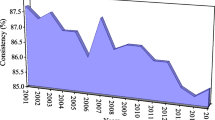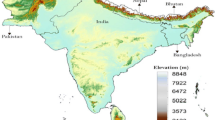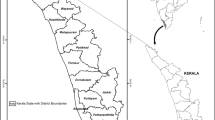Abstract
Mapping land cover changes (LCC) cover three decades over North and West Africa regions provides critical insights for the climate research that inspects the land-atmosphere interaction. LCC is a serious problem in the Earth science domain for this impacts the regional climate by modifying the distribution of terrestrial carbon stocking and roughness of the Earth’s surface. In this study, the normalized difference vegetation index (NDVI) generated from advanced very high resolution radiometer (AVHRR) was used to produce a continuous set of annual land cover (LC) maps of land cover over North and West Africa between 1982 and 2015, based on the random forest classification. We used the MODIS land cover product (MCD12Q1) as a reference data for training the classifier. The result has validated using annual LC maps listed by time series and the spatio-temporal dynamics of land cover has illustrated over the last three decades. The comparison with Google Earth image 2015 shows that the overall accuracy of the simpler nine-class type of our land cover 2015 map is 76% and 2% higher than that of the MODIS map of the same year. The detection of changes indicated that over the last three decades, the urban and built-up, barren or sparsely vegetated, savannas and deciduous broadleaf forest have increased; in contrast, the open shrublands, woody savannas and water bodies have decreased.










Similar content being viewed by others
References
Belgiu M, Csillik O (2018) Sentinel-2 cropland mapping using pixel-based and object based time-weighted dynamic time warping analysis. Rem Sens Envi. 204:509–523
Belgiu M, Drăguţ L (2016) Random forest in remote sensing: a review of applications and future directions. ISPRS J Photogram Rem Sens 114:24–31
Biradar C, Thenkabail P, Noojipady P, Li Y, Dheeravath V, Turral H, Velpuri NM, Gumma M, Reddy GPO, Cai X (2009) A global map of rainfed cropland areas (GMRCA) at the end of last millennium using remote sensing. Inter J Appl Earth Obser Geoinfo 11:114–129
Breiman L (2001) Random forests. Mach Learn 45:5–32
Channan S, Collins K, Emanuel W (2014) Global mosaics of the standard MODIS land cover type data. University of Maryland and the Pacific Northwest National Laboratory, College Park, Maryland, USA
Chen T, Wang G, Yuan W, Li A, Liu YY (2016) Asymmetric NDVI trends of the two cropping seasons in the Huai River basin. Remote Sens Lett 7:61–70
Dahinden C (2011) An improved random forest approach with application to the performance prediction challenge datasets. Hands-On Pattern Recognition, Challenges in Machine Learning 1:223–230
Callo-Concha D, Gaiser T, Webber H, Tischbein B, Müller M and Ewert F (2013) Farming in the West African Sudan Savanna: insights in the context of climate change 8:4693–4705
Eklundh L, Jönsson P (2015) TIMESAT 3.2 with parallel processing software manual. http://web.nateko.lu.se/timesat/docs/TIMESAT32_software_manual.pdf
Erika R, Celso BL, Martin H, Erik L, Robert O, Arief W, Daniel M, Louis V (2015) Assessing change in national forest monitoring capacities of 99 tropical countries. Forest Eco Manag 352:109–123
Rurangwa E (2000) Agriculture and land use changes in West Africa: drivers, impacts and strategies for sustainable agricultural intensification. Land & Water Officer, FAO/RAF
Friedl MA, Sulla-Menashe D, Tan B, Schneider A, Ramankutty N, Sibley A, Huang X (2010) MODIS collection 5 global land cover: algorithm refinements and characterization of new datasets. Remote Sens Environ 114:168–182
Ghaleb F, Mario M, Abbas F (2016) Detecting changes in vegetation trends in the Middle East and North Africa (MENA) region using SPOT vegetation. Cartographie, Imagerie, SIG
Guan K, Wood EF, Medvigy D, Kimball J, Pan M, Caylor KK, Sheffield J, Xu X, Jones MO (2014) Terrestrial hydrological controls on land surface phenology of African savannas and woodlands. J Geophys Res Biogeosci 119:1652–1669
He YQ, Lee E, Warner TA (2017) A time series of annual land use and land cover maps of China from 1982 to 2013 generated using AVHRR GIMMS NDVI3g data. Rem Sens Envi 199:201–217
Holben BN (1986) Characteristics of maximum value composite images from temporal AVHRR data. Int J Remote Sens 7:1417–1434
Hopfner and Scherer (2011) Analysis of vegetation and land cover dynamics in north-western Morocco during the last decade using MODIS NDVI time series data. Biogeosciences 8:3359–3373
Immitzer M, Vuolo F, Atzberger C (2016) First experience with Sentinel-2 data for crop and tree species classifications in Central Europe. Rem Sens 8:166
James M, Kalluri SN (1994) The pathfinder AVHRR land data set: an improved coarse resolution data set for terrestrial monitoring. Int J Remote Sens 15:3347–3363
Jense Pinzon JR (2016) Introductory digital image processing: a remote sensing perspective, 4th edn. Pearson, New Jersey
Jönsson P, Eklundh L (2004) TIMESAT program for analyzing time-series of satellite sensor data. Comput Geosci 30:833–845
Julien A, Catherine M (2008) Vegetation land cover change mapping of West African coastal zone from remotely sensed images: example of “Rivières-du-Sud” from Salum Delta (Senegal) to Rio Geba (Guinea-Bissau). Paris University Diderot, Pôle de Recherche pour l’Organisation et la Diffusion de l’Information Géographique
Khorram S (1999) Accuracy assessment of remote sensing-derived change detection. Bethesda, MD: American Society for Photogrammetry and Remote Sensing
Kussul N, Skakun S, Shelestov A, Lavreniuk M, Yailymov B, Kussul O (2015) Regional scale crop mapping using multi-temporal satellite imagery. ISPRS - International Archives of the Photogrammetry, Rem Sens and Spat Infor Sci. XL-7/W3:45–52
Lawrence PJ, Chase TN (2007) Representing a new MODIS consistent land surface in the Community Land Model (CLM 3.0). J Geophys Res Biogeosci
Lawrence PJ, Feddema JJ, Bonan GB, Meehl GA, O'Neill BC, Oleson KW, Levis S, Lawrence DM, Kluzek E, Lindsay K (2012) Simulating the biogeochemical and biogeophysical impacts of transient land cover change and wood harvest in the Community Climate System Model (CCSM4) from 1850 to 2100. J Clim 25:3071–3095
Liaw A, Wiener M, Breiman L, Cutler A (2009) Package “Randomforest”. https://cran.rproject.org/web/packages/randomForest/randomForest.pdf
Liu J, Heiskanen J, Aynekulu E, Maeda EE, Pellikka PK (2016) Land cover characterization in West Sudanian Savannas using seasonal features from annual Landsat time series. Remote Sens 8:365
Lucas R, Blonda P, Bunting P, Jones G, Inglada J, Arias M, Charnock R (2015) The earth observation data forhabit at monitoring (EODHaM) system. Int J Appl Earth Obser and Geoinfor 37:17–28
Lunetta RS, Knight JF, Ediriwickrema J, Lyon JG, Worthy LD (2006) Land-cover change detection using multi-temporal MODIS NDVI data. Remote Sens Environ 105:142–154
Mas JF (1999) Monitoring land-cover changes: a comparison of change detection techniques. Inter J Rem Sens. 20:139–152
Maxwell AE, Warner TA, Strager MP (2016) Predicting Palustrine wetland probability using random forest machine learning and digital elevation data-derived terrain variables. Photogramm Eng Remote Sens 82:437–447
Mertens B, Lambin E (2000) Land-cover-change trajectories in southern Cameroon. Ann Assoc Am Geogr 90:467–494
Meyer H, Kühnlein M, Appelhans T, Nauss T (2016) Comparison of four machine learning algorithms for their applicability in satellite-based optical rainfall retrievals. Atmo Res 169:424–433
Mingwei Z, Qingbo Z, Zhongxin C, Jia L, Yong Z, Chongfa C (2008) Crop discrimination in northern China with double cropping systems using Fourier analysis of time-series MODIS data. Inter J Appl Earth Obser Geoinfor 10:476–485
Odjugo PAO, Ikhuoria AI (2003) The impact of climate change and anthropogenic factors on desertification in the semi-arid region of Nigeria. Glob J Environ Sci 2:118–126
Olofsson P, Foody GM, Herold M, Stehman SV, Woodcock CE, Wulder MA (2014) Good practices for estimating area and assessing accuracy of land change. Remote Sens Environ 148:42–57
Pal M (2005) Random forest classifier for remote sensing classification. Inter J Rem Sens 26:217–222
Pelletier C, Valero S, Inglada J, Champion N, Dedieu G (2016) Assessing the robustness of random forests to map land cover with high resolution satellite image time series over large areas. Rem Sens Envi. 187:156–168
Pinzon JE, Tucker CJ (2014) A non-stationary 1981-2012 AVHRR NDVI3g time series. Remote Sens 6:6929–6960
Pittman K, Hansen MC, Becker-Reshef I, Potapov PV, Justice CO (2010) Estimating global cropland extent with multi-year MODIS data. Rem Sens. 2:1844–1863
Rodriguez-Galiano VF, Chica-Olmo M, Abarca-Hernandez F, Atkinson PM, Jeganathan C (2012a) Random Forest classification of Mediterranean land cover using multi-seasonal imagery and multi-seasonal texture. Rem Sens Envi 121:93–107
Rodriguez-Galiano VF, Ghimire B, Rogan J, Chica-Olmo M, Rigol-Sanchez JP (2012b) An assessment of the effectiveness of a random forest classifier for land-cover classification. ISPRS J Photogramm Remote Sens 67:93–104
Rosenfield GH, Fitzpatrick-Lins K (1986) A coefficient of agreement as a measure of thematic classification accuracy. Photogramm Eng Remote Sens 52:223–227
Shi D, Yang X (2016) An assessment of algorithmic parameters affecting image classification accuracy by random forests. Photogramm Eng Remote Sens 82:407–417
Smits PC, Dellepiane SG, Schowengerdt RA (1999) Quality assessment of image classification algorithms for land-cover mapping: a review and proposal for a cost-based approach. Inter J Remote Sens 20:1461–1486
Tappan GG, Cushing WM, Cotillon SE, Mathis ML, Hutchinson JA, Dalsted KJ (2016) West Africa land use land cover time series: U.S. Geological Survey data release
Townshend JR, Justice C, Kalb V (1987) Characterization and classification of South American land cover types using satellite data. Int J Remote Sens 8:1189–1207
Tucker CJ, Pinzon JE, Brown ME, Slayback DA, Pak EW, Mahoney R, Vermote EF, El Saleous N (2005) An extended AVHRR 8-km NDVI dataset compatible with MODIS and SPOT vegetation NDVI data. Int J Remote Sens 26:4485–4498
Warrens MJ (2015) Properties of the quantity disagreement and the allocation disagreement. Int J Remote Sens 36:1439–1446
Zheng B, Myint SW, Thenkabail PS, Aggarwal RM (2015) A support vector machine to identify irrigated crop types using time-series Landsat NDVI data. Inter J Appl Earth Obs and Geoinfor 34:103–112
Acknowledgements
This work was funded by the CAS Strategic Priority Research Program (No. XDA19030402) and the “Taishan Scholar” Project of Shandong Province and Key Basic Research Project of Shandong Natural Science Foundation of China (no. ZR2017ZB0422). We also thank the four anonymous reviewers for their constructive comments and suggestions.
Author information
Authors and Affiliations
Corresponding author
Additional information
Responsible editor: Philippe Garrigues
Publisher’s note
Springer Nature remains neutral with regard to jurisdictional claims in published maps and institutional affiliations.
Rights and permissions
About this article
Cite this article
Henchiri, M., Ali, S., Essifi, B. et al. Monitoring land cover change detection with NOAA-AVHRR and MODIS remotely sensed data in the North and West of Africa from 1982 to 2015. Environ Sci Pollut Res 27, 5873–5889 (2020). https://doi.org/10.1007/s11356-019-07216-1
Received:
Accepted:
Published:
Issue Date:
DOI: https://doi.org/10.1007/s11356-019-07216-1




